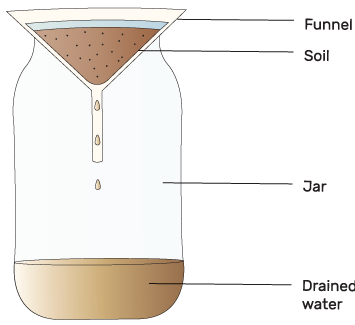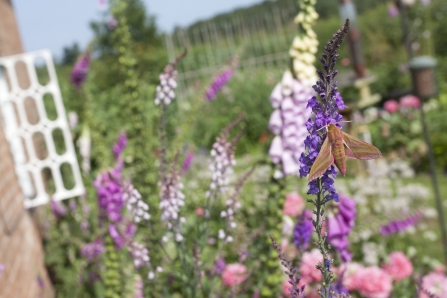Invite a cloud of beautiful insects into your gardens by providing a source of nectar
Many of our prettiest insects are nectar feeders that need flowers for their survival. Butterflies, moths, bees and hoverflies all need sources of nectar and pollen to thrive. As they travel from flower to flower they also pollinate them and enable them to set seed or bear fruit.
Setting up a nectar café is of benefit to your plants as well as allowing you to enjoy the flitting of beautiful butterflies from the comfort of your garden!
Know your soil
When planting an area for wildlife, it is important to know your soil type. Not all the plants listed below will be suitable for all soil types, and may not grow properly or die completely.
pH test
A simple test to find out if your soil is acid, alkaline or neutral can be carried out using a soil testing kit from your local garden centre, which uses colour as an indicator.
The solution will turn yellow-orange for acid soil, green for neutral and dark green for alkaline soil. Most plants prefer a pH of 6.5 to 7 – the point where nutrients are most easily available.
Water retention
Clay and peat soils hold water better than sandy and chalk soils. This test will show if your soil will become waterlogged in wet weather, or dry out quickly in summer.
To test the water retention of your soil:
Fold a piece of kitchen paper into a funnel and place in a jar, then fill a small measuring jug with a recorded amount of water. Place a tablespoon of your dry soil in the funnel and add water to the centre of the soil. Stop adding water when the first drop falls into jar, noting how much water you have added. Wait until soil has drained. Measure the volume of drained water: if over half of the added water is recovered, your soil is well drained.

Designing your nectar café
- Choose a sheltered sunny spot
- Place each plant in groups or drifts so that the colour and scent are easy to detect
- Prolong the flowering season – select plants so that you have a show of flowers from early spring to late autumn
- Flowers with a simple (often flat) structure, like old cottage varieties, are easiest for insects to feed from
- Remember to provide a night-time feast for moths; plant some night-scented flowers
- Many herbs are highly attractive to insects, so add them into the mix, or design a dedicated herb garden

Elephant hawkmoth - Tom Marshall
Planting your nectar café
Take a look at our suggestions for plants and flowers through the seasons, or take a look at the RHS 'Plants for Pollinators' download below.
Plants by season
Choose a mixture of seasonal flowering plants, shrubs and trees to ensure a year round food source in your garden.
Early season
- Aubaretia
- English bluebell
- Flowering currant
- Grape hyacinth
- Lungwort
- Primrose
- Sweet violet
- Winter aconite
- Wood anemone
- Yellow alyssum
Mid season
- Buddleia
- Heather
- Lady’s bedstraw
- Lavender
- Mallow
- Purple toadflax
- Rock cress
- Sea holly
- Verbena
- Wallflower
Late season
- Coneflower
- French marigold
- Golden rod
- Honeysuckle
- Ice plant
- Ivy
- Meadow saffron
- Michaelmas daisies
- Perennial sunflower
- Red valerian
Plants for butterflies
Growing host plants in the garden is not necessarily guaranteed to attract the relevant butterflies, but it's worth experimenting to see which species find your garden most suitable.
Breeding butterfly host plants
| Species | Host plant |
| Comma | Common nettle, hop, currant, gooseberry |
| Common blue | Common bird’s foot trefoil, other small legumes |
| Dingy skipper |
Common bird’s foot trefoil, horseshoe vetch |
| Green-veined white | Cabbage family, cuckoo flower, charlock, nasturtium |
| Holly blue | Holly, ivy |
| Large skipper | Cock’s foot, false brome |
| Large white | Cabbage family, nasturtium, wild mignonette |
| Meadow brown |
Grasses: Fescue species, meadow-grass, bents |
| Orange tip | Cuckoo flower, garlic mustard |
| Painted lady | Thistles, common nettle |
| Peacock | Common nettle |
| Red admiral | Common nettle |
| Ringlet Cock’s foot | False brome, tufted hair-grass, common couch |
| Small copper | Common sorrel, sheep’s sorrel |
| Small skipper | Yorkshire fog |
| Small tortoiseshell | Common nettle |
| Small white | Cabbage family, nasturtium, hedge mustard, garlic mustard |
| Wall | False brome, cock’s foot, Yorkshire fog, wavy hair grass |
- Wild About Gardens Pollinator Booklet (http://live-twt-d8-lincolnshire.pantheonsite.io/sites/default/files/2018-05/WAG%202014%20Pollinator%20Booklet_0.pdf)
- Garden for Butterflies (http://live-twt-d8-lincolnshire.pantheonsite.io/sites/default/files/2018-05/ButterflyGardening.pdf)
- Attract Bumblebees (http://live-twt-d8-lincolnshire.pantheonsite.io/sites/default/files/2018-05/GardenBumblebees.pdf)
- Garden flowers (http://live-twt-d8-lincolnshire.pantheonsite.io/sites/default/files/2018-05/flowers.pdf)
- Wildlife Watch butterfly garden (http://live-twt-d8-lincolnshire.pantheonsite.io/sites/default/files/2018-05/BEE%26BUTTERFLY-GARDEN.jpg)
- The Life of Bees (http://www.thelifeofbees.co.uk/)
More actions for wildlife
There's lots of small things you can do in your garden, courtyard of windowsill that will benefit wildlife. Take a look at some simple ideas below to see how you can take action for wildlife.











